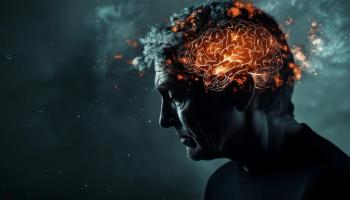
Which Came First, Cannabis Use or Psychosis?
Explore the complex interaction of cannabis and psychosis, and the sociocultural stressors and resulting neurobehavioral symptoms.
TALES FROM THE CLINIC
-Series Editor Nidal Moukaddam, MD, PhD
In this installment of Tales of the Clinic: The Art of Psychiatry, we explore the relationship between cannabis use, psychosis, and potential legal issues. Increasing recreational cannabis use, accompanied by availability given increasing legalization, highlights the risk of psychiatric comorbidity associated with
Case Vignette
“Gary” is a 25-year-old African-American veteran who was recently discharged from the US Army after serving for 4 years. During his service, he suffered a
Gary has been unable to keep multiple jobs for more than a few weeks, and his parents are growing increasingly frustrated with him. He also declined disability benefits. Gary's parents have been doing their best to provide him with the support he needs, but also recognize that his continued cannabis use poses a problem. They make sure to check in on him daily and offer him a listening ear when he needs one. They encourage him to engage in activities that he used to enjoy.
His parents have actively explored mental health services in the area and are hopeful that they can find a way to help Gary, even though the closest psychiatrist works 3 hours away from their hometown. His parents tell you during their first appointment that you are the first psychiatrist to see Gary.
Frustrated with his situation, Gary tells you he smokes cannabis because it helps “quiet his mind and sometimes the voices.” This week, Gary shares that he was found by police at a busy intersection running at cars and pedestrians. Gary was taken to jail for cannabis intoxication and possession. His parents hired a lawyer to fight these charges, but Gary’s psychotic symptoms prevent him from working with his legal counsel. With adherence to antipsychotic medications and cooperation with his lawyer, it is possible Gary could fight these charges. However, Gary tells you he does not want to stop smoking cannabis. He also does not want to try the medications you offer because the voices tell him it is not necessary. He points out his incarceration and your recommendations are unfair since cannabis is being legalized in many states.
Discussion
Stories like Gary’s are all too common.
Earlier epidemiological studies merely linked heavy, sustained use of cannabis to development of first break
As of 2020, of the 15% of the US population who met criteria for
As a wave of cannabis legalization begins to sweep the country, it is important to distinguish recreational from problematic use. Problematic use entails a variety of factors including: a failure to fulfill obligations, social and interpersonal problems, physiological dependence, hazardous use, and unsuccessful attempts to cut down or stop when using larger amounts over a long period of time.
While cannabis may not be legalized in some states, the active ingredient—the compound
Legal Implications
State laws and public perceptions surrounding cannabis have been changing rapidly. In the state of Texas, marijuana possession is at least a misdemeanor charge with jail time, and/or fines, progressing to felony possession if a person is found with more than four ounces. By contrast, 19 other states, Washington, DC, and Guam have legalized the recreational use of cannabis. At least 37 states have approved cannabinoid products for medicinal use.
The Marijuana Opportunity Reinvestment and Expungement Act passed by the US House of Representatives in April 2022 sought to decriminalize marijuana. This bill meant that cannabis would be removed from the list of drugs regulated by the Controlled Substances Act, federal criminal penalties for cannabis use would be eliminated, and past federal cannabis convictions would be expunged. However, no bill to decriminalize cannabis has successfully passed the Senate. To address the issue, in October 2022, US President Joe Biden announced that he would grant pardons for federal marijuana possession convictions, urging state governors to do the same for state offenses.13
These events are steps in a positive direction for thousands of individuals, particularly minority groups who are disproportionately arrested and incarcerated. An ACLU report from 2020 states that an African American individual is 3.64 times more likely to be arrested for marijuana possession, even though Black and white rates of cannabis use are the same.14 In some states, Black individuals are up to even 10 times more likely to be arrested.14 This trend applies to every single state and is prevalent in both rural and urban settings, an effect of a political effect called in the “War on Drugs.” Beyond actual incarceration, felony convictions prevent individuals from employment, housing options, and even the right to vote, making this an issue of racial equity.
Individual Risk Profile
Gary faced an increased risk of arrest for cannabis possession due to his race/ethnicity. Before his arrest, Gary’s TBI history increased his impulsivity risk and could have complicated his chances at educational attainment and occupational success. Additionally, his history of military trauma may have made continued use of cannabis more likely. Gary likely used cannabis for its ability to stifle trauma intrusion and hyperarousal symptoms, as cannabinoids reduce responses to conditioned fear cues, impair retrieval of aversive memories, and trigger the extinction of unwanted memories.15
In light of his psychotic symptoms and unsafe behavior while intoxicated, Gary would have benefited from a psychiatric evaluation instead of incarceration, which could hurt his future employment prospects. Gary’s refusal of psychiatric medications and limited insight about the dangers of cannabis use and his legal predicament, place him in a real quandary. Yet, the severity of his psychotic symptoms is not sufficient to justify involuntary inpatient psychiatric hospitalization. Clinicians need to be ready for this type of complicated presentation as cannabis becomes increasingly legalized.
Additionally, while risk of cannabis use in triggering psychosis is recognized, the risk of use on ongoing psychotic disorders and in the exacerbation of other disorders (involving mood, concentration, and other symptoms) are not fully understood. The impact of prenatal exposure risks, early use, exposure in early adolescence, are also not fully understood if the user is a woman of child-bearing age. Lastly, the impact of using high concentration THC compounds for prolonged periods of time will need to be studied as legalization unfolds. The Adolescent Brain Cognitive Development (ABCD) Study, launched by the National Institute of Health in 2015, aims to track brain development in children and adolescents starting at age 9 to answer such questions.
Concluding Thoughts
Outpatient motivational interviewing may have the greatest impact in promoting a collaborative patient relationship. It may not be readily apparent to patients with underlying psychotic disorders just how risky substance use can be, but the legal consequences can be life-altering, impacting their prognoses. Building family support through psychoeducation can help destigmatize mental health care attainment and enhance patient motivation for sobriety. In a political climate where our patients face discrimination, it is imperative for clinicians to do what we can to treat our patients holistically.
Dr Shenoi is an addiction psychiatry fellow at Baylor College of Medicine in Houston, TX. Dr Jessa is a psychiatry resident at Baylor College of Medicine in Houston, TX. Dr Moukaddam is an associate professor in the Menninger Department of Psychiatry and Behavioral Sciences, Baylor College of Medicine, as well as the Ben Taub Adult Outpatient Services director and the medical director of the Stabilization, Treatment & Rehabilitation (STAR) Program for Psychosis, also at Baylor College of Medicine. She also serves on the Psychiatric Times Advisory Board. Dr Avellaneda Ojeda is an associate professor in the Menninger Department of Psychiatry and Behavioral Sciences at Baylor College of Medicine in Houston, TX.
References
1. UNODC. World drug report 2019 Booklet 1, Executive Summary. Word Drug Report (2019).
2. Di Forti M, Quattrone D, Freeman TP, et al.
3. van Os J, Bak M, Hanssen M, et al.
4. Livne O, Shmulewitz D, Sarvet AL, et al.
5. Ksir C, Hart CL.
6. Murray RM, Englund A, Abi-Dargham A, et al.
7. Paparelli A, Di Forti M, Morrison PD, Murray RM.
8. Morgan CJA, Freeman TP, Powell J, Curran HV.
9. Nieman DH, Dragt S, van Duin EDA, et al.
10. Key substance use and mental health indicators in the United States: results from the 2020 National Survey on Drug Use and Health (NSDUH).Substance Abuse and Mental Health Services Administration. October 2021. Accessed August 15, 2023.
11. Agosti V, Nunes E, Levin F.
12. Regier DA, Farmer ME, Rae DS, et al.
13. Rachko TJ. Biden Administration takes steps on marijuana justice reform: pardon begins to address harm to communities of color. Human Rights Watch. October 8, 2022. Accessed August 15, 2023.
14. A tale of two countries: racially targeted arrests in the era of marijuana reform. American Civil Liberties Union. 2020. Accessed August 15, 2023.
15. LaFrance EM, Glodosky NC, Bonn-Miller M, Cuttler C.
Newsletter
Receive trusted psychiatric news, expert analysis, and clinical insights — subscribe today to support your practice and your patients.














